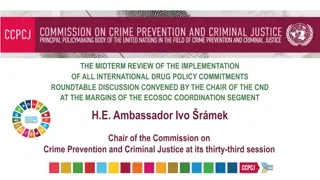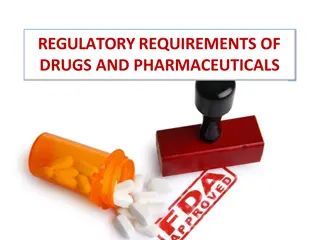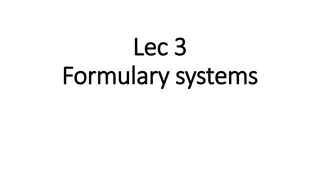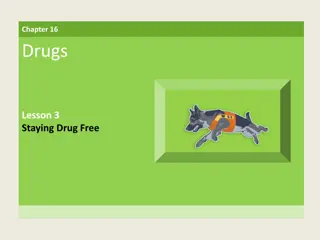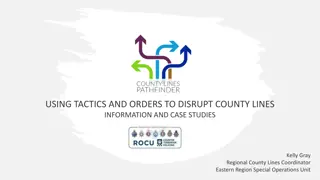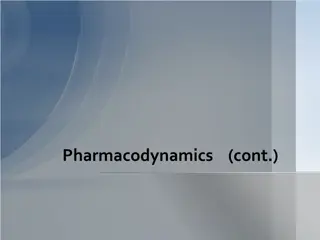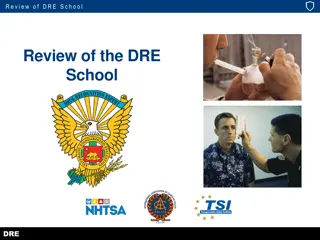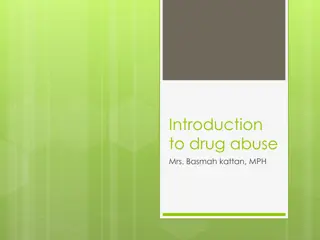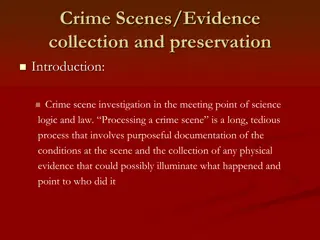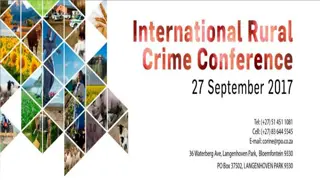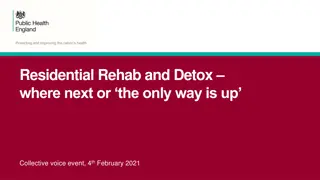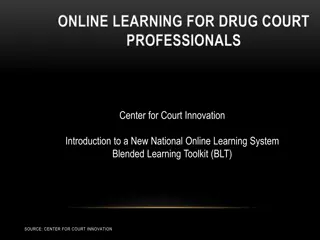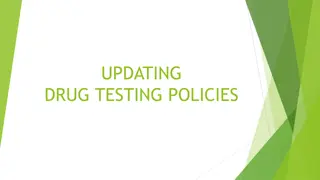Age-Friendly App: Managing Drug-Drug Interactions Between Prescriptions and OTC Analgesics
The Age-Friendly app addresses the crucial issue of drug-drug interactions between current prescriptions and over-the-counter analgesics in the geriatric population. With a significant percentage of OTC sales attributed to older adults, there is an increased risk of adverse drug events due to polyph
1 views • 25 slides
Exploring the Implementation of CPTED Strategies in Crime Prevention
Understanding CPTED (Crime Prevention Through Environmental Design) and its application is crucial for reducing crime and improving quality of life. This approach involves designing and using the built environment effectively to create safer communities. The delivery of CPTED involves collaboration
6 views • 21 slides
Roundtable Discussion on International Drug Policy Commitments Midterm Review
The roundtable discussion focused on the challenges and responses related to international drug policy commitments, including the abuse, cultivation, trafficking of narcotic drugs, and organized crime links. Efforts outlined in the Kyoto Declaration to prevent crime and disrupt criminal groups, part
0 views • 7 slides
Essex Police and Crime Plan 2021-2024 Monthly Performance Update July 2023
The Police and Crime Plan 2021-2024 introduced measures focusing on targeted prevention and early intervention by Essex Police. Key priorities were assessed, with grades ranging from Good to Requires Improvement. Confidence in local police showed a decrease compared to the previous year but was high
1 views • 46 slides
Understanding Regulatory Requirements of Drugs and Pharmaceuticals
Drug regulation involves controlling drug use through international agreement authorities like the FDA, EMA, and PMDA. The FDA plays a crucial role in drug evaluation and research, biologic evaluation, devices, and food safety. There are various types of applications for drug approval, along with a
0 views • 28 slides
Polymeric Controlled Drug Delivery Systems
Polymeric controlled drug delivery systems play a crucial role in regulating drug release through diffusion, solvent penetration, and chemical mechanisms. These systems include diffusion-controlled, solvent-controlled, and chemically-controlled devices, each operating based on specific principles. S
0 views • 33 slides
Renal Pharmacology: Drug Excretion and Renal Clearance Questions
This comprehensive set of questions and answers covers topics related to drug excretion and renal pharmacology. It includes information on glomerular filtration, drug excretion mechanisms, dosage adjustments in renal impairment, factors influencing drug excretion, and the effects of long-term NSAID
0 views • 55 slides
Understanding Nasopulmonary Drug Delivery System
Nasopulmonary drug delivery system, utilizing the nasal route for drug administration, offers advantages such as hepatic first-pass metabolism avoidance and rapid drug absorption. This system is beneficial for pharmacologically active compounds with poor stability in gastrointestinal fluids. While i
0 views • 35 slides
Understanding Physicochemical Properties of Drugs
The physicochemical properties of drugs play a crucial role in their pharmacological effects. These properties include physical and chemical characteristics that influence interactions with biomolecules. Solubility, partition coefficient, and dissociation constant are key factors affecting drug beha
1 views • 46 slides
Understanding Formulary Systems in Healthcare
A formulary is a dynamic list of medications curated by healthcare professionals to guide drug selection based on efficacy, safety, cost, and patient acceptability. It plays a vital role in promoting evidence-based and cost-effective drug therapy, improving communication between prescribers and phar
0 views • 17 slides
Ways to Stay Drug Free: Lessons for Teens and Families
Understanding the reasons behind drug usage among teens, this lesson provides valuable resources and strategies to stay drug-free. It emphasizes the importance of making healthy decisions and offers alternatives to drug use. Additionally, it highlights the significance of saying no to drugs, provide
0 views • 17 slides
2017 Annual Crime Report Highlights and Trends in Uganda
Detailed analysis of the 2017 annual crime report in Uganda presented by AIGP Akullo Grace, covering various aspects including crime comparison, performance metrics, highest reported crimes, and crime trends. The report outlines an increase in reported cases compared to 2016, with insights into spec
0 views • 23 slides
Exploring Gender Disparities in Crime
Delve into the intricate relationship between crime and gender by examining key sociological concepts like social control, chivalry thesis, and gender socialization. Understand why men are more inclined towards drug use compared to women. Explore questions on historical crime trends and the increasi
0 views • 16 slides
Understanding the Hatch-Waxman Act: Promoting Affordable Generic Drugs
The Hatch-Waxman Act, also known as The Drug Price Competition and Patent Term Restoration Act, was enacted in 1984 to amend patent laws and the Federal Food, Drug, and Cosmetic Act. It aims to reduce costs associated with generic drug approval, allow early experimental use, compensate branded drug
0 views • 49 slides
Using Tactics and Orders to Disrupt County Lines: Case Studies and Strategies
Exploring the approach of using tactics and orders to disrupt county lines, this content outlines the Drug Dealing Telecommunications Restriction Order (DDTRO) process and its impact on drug supply chains. Case studies like the successful DDTRO conducted by the North West Regional Organised Crime Un
0 views • 21 slides
Understanding Biopharmaceutics: pH Partition Theory and Drug Absorption
Biopharmaceutics explores how drug properties and administration methods impact drug absorption. Factors affecting oral absorption include membrane physiology and drug partitioning based on pH levels. The pH partition theory, explained by Brodie et al., highlights the role of drug lipid solubility a
0 views • 9 slides
Importance of In-Vitro Dissolution Testing in Drug Assessment
In drug development, in-vitro dissolution testing plays a crucial role in evaluating drug release from tablets when in-vivo bioavailability studies are limited. By ensuring drug release is close to 100% and uniform batch to batch, these tests help assess drug availability and effectiveness. Regulato
10 views • 10 slides
Understanding Pharmacodynamics: Potency and Efficacy
Pharmacodynamics explores how drugs interact with receptors in the body, affecting the magnitude of drug effects based on concentration. Graded dose-response relationships, potency, and efficacy play key roles in determining drug efficiency. Potency reflects the amount of drug needed for a specific
0 views • 21 slides
Essex Police and Crime Plan 2016-2020 Performance Update November 2019
The November 2019 update on Essex Police's performance under the Police and Crime Plan 2016-2020 reveals a 13.6% increase in all crime for the period to November 2019 compared to the previous year. While some improvements have been made in various priorities, concerns persist in areas such as local
0 views • 15 slides
Understanding Drug Absorption, Excretion, and Bioavailability in Humans
Delve into the complex processes of drug absorption, excretion, and bioavailability in the human body. Learn about the various factors affecting drug absorption from the gastrointestinal tract, including biological, physiochemical, and pharmaceutical factors. Explore the mechanisms of drug transport
0 views • 24 slides
Understanding Quantitative Aspects of Drug Action
Explore the quantitative aspects of drug action, including drug receptor binding, concentration binding curves, dose-response curves, and types of antagonism. Learn to relate drug concentration to receptor binding capacity and response produced. Discover how concentration binding curves and dose-res
0 views • 29 slides
Review of DRE School and Drug Evaluation Techniques
Explore key topics such as the definition of drugs for DRE purposes, basic drug statistics, review of symptomatology, and vital signs assessment in the context of Drug Recognition Expert (DRE) training. Learn about CNS depressants, stimulants, hallucinogens, and analogs, as well as vital signs like
0 views • 29 slides
Study on Juvenile Drug Crime Prevention in Taiwan: Insights from ACS Conference 2020
This presentation at the Asian Criminological Society Conference 2020 delves into the current situation, dilemmas, and responses regarding juvenile drug crime prevention in Taiwan. The presenter, Zeng Li-Wen, a PhD student at Central Police University in Taiwan, provides valuable insights based on t
0 views • 20 slides
Understanding Drug Abuse: Definitions, Effects, and Stages
Drug abuse is a serious issue involving various substances like prescription drugs, alcohol, and illegal drugs. This includes terms and definitions, effects on the body and mind, stages of addiction, and withdrawal symptoms. Factors influencing drug action and reasons for drug use are also explored.
4 views • 45 slides
Understanding Drug Targets and Mechanisms of Action
Explore the intricate world of pharmacokinetics and pharmacodynamics, from drug absorption to their interaction with biological molecules. Learn about different drug targets, such as proteins and ions, and how drugs alter their biochemical and biophysical activities. Dive into molecular mechanisms o
3 views • 17 slides
Crime in Scotland Quiz: Test Your Knowledge about Crime Statistics
Explore a engaging quiz featuring questions related to crime in Scotland, covering topics such as surveys, crime rates, property crime, violent crime, police views, public perceptions, and more. From the Edinburgh Study of Youth Transitions & Crime to data on adults' experiences and perceptions, thi
0 views • 4 slides
Transitioning to Incident-Based Crime Reporting: Enhancing Transparency and Accountability
Anytown Police Department (APD) is leading the transition from Summary Reporting to Incident-Based Reporting through the National Incident-Based Reporting System (NIBRS). This change promotes transparency, provides detailed crime data to the public, and improves statewide and national crime statisti
3 views • 17 slides
Crime Statistics and Severity Analysis: RCMP Sooke Detachment
An overview of crime severity measurements, property crime rates, and violent crime rates in Sooke and comparable detachments. The data includes crime severity index scores, crime type contributions by year, and property/violent crime rates per 1000 population. The analysis shows changes over time,
0 views • 8 slides
Understanding White Collar Crime and Occupational Crime
White collar crime encompasses various offenses such as fraud, embezzlement, forgery, collusion, and tax evasion. This type of crime can often go undetected due to its complex nature and the difficulty in investigating it. Occupational crime, on the other hand, involves employees stealing from their
0 views • 7 slides
Understanding White Collar Crime: Impact on Society
White-collar crime, rooted in the elite's professional roles, has seen a rise in recent years, often linked to large corporations. Edwin Sutherland defined this type of crime, highlighting the intelligence behind its execution and the significant economic losses incurred. Contrasted with blue-collar
0 views • 16 slides
Impact of Socioeconomic Conditions on Drug Use Disorders: Insights from World Drug Report 2020
The World Drug Report 2020 highlights the strong correlation between socioeconomic factors and drug use disorders. Studies reveal that communities facing poverty, violence, and social inequality are at a higher risk of drug overdoses and addiction. Factors like income inequality, lack of social capi
0 views • 17 slides
Understanding Crime and Deviance: Control, Solutions, and Measurement
Exploring the concepts of crime and deviance, this content delves into various aspects such as types of deviance, agents of social control, solutions to crime, the penal system, methods of punishment, and measurement of crime through victim surveys and self-reported studies. It highlights the comple
0 views • 43 slides
Crime Scenes and Evidence Collection: The Intersection of Science, Logic, and Law
Crime scene investigation is a meticulous process that involves documenting the scene conditions and collecting physical evidence to unravel the truth behind a crime. Understanding what constitutes a crime scene, the importance of evidence, conducting initial surveys, taking precautions, and conduct
0 views • 40 slides
Addressing Rural Crime in Agriculture: Challenges and Solutions
The presentation highlights the global issue of crime in farming communities, discussing manifestations of crime rates, characteristics of farmers in dealing with crime, features of rural environments, and approaches to combating crime. It sheds light on various crimes affecting agriculture such as
0 views • 10 slides
Understanding Targeted Clinical Investigation in Pharmacovigilance
Targeted clinical investigation plays a crucial role in pharmacovigilance by further evaluating significant risks identified in pre-approval clinical trials. This involves conducting pharmacokinetic and pharmacodynamic studies, genetic testing, interaction studies, and large simplified trials to ass
0 views • 12 slides
Transforming Drug Treatment: Collective Voice Event Insights
Explore insights from the Collective Voice event focusing on residential rehab, detox services, and the recent government funding injection of £80 million for drug treatment. The event discusses challenges, funding allocations, and strategies to address drug-related crime and deaths through enhance
0 views • 13 slides
Advances in Ophthalmic Drug Delivery Systems
This content explores various advanced ophthalmic drug delivery systems including erodible ophthalmic inserts, soluble ocular drug inserts, new ophthalmic drug delivery systems, and bioadhesive ophthalmic drug inserts. These innovative systems aim to provide accurate dosing, prolonged drug release,
0 views • 8 slides
Understanding Situational Crime Prevention Strategies
Situational crime prevention strategies aim to reduce crime by altering environmental conditions, influencing offender decisions, and targeting crime opportunities. Primary prevention focuses on modifying physical and social environments, while secondary prevention aims to identify potential offende
1 views • 31 slides
Innovative Online Learning for Drug Court Professionals
Center for Court Innovation has introduced a new National Drug Court Online Learning System aimed at assisting drug court professionals. This system offers free access to web-based training, expert video lessons, virtual site visits to drug treatment courts, practitioner interviews, and a resource l
0 views • 8 slides
Understanding Drug Testing Policies in the Workplace
The Drug-Free Workplace Act of 1988 mandates federal grant recipients to implement zero-tolerance drug policies to maintain a drug-free environment. Employers must establish clear policies, conduct awareness programs, offer counseling and rehabilitation services, and impose penalties for violations.
0 views • 19 slides


